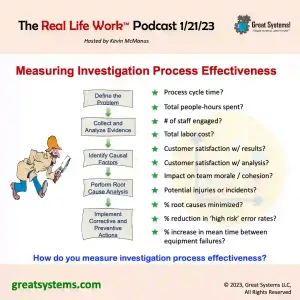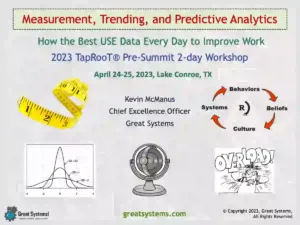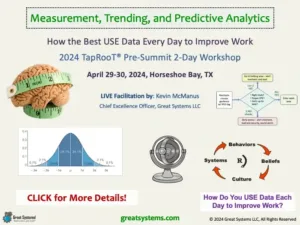In this ‘How to Measure Investigation Process Effectiveness’ Real Life Work podcast, I share multiple options to measure investigation process performance.
How to Measure Investigation Process Effectiveness Podcast
Often, my TapRooT® root cause analysis course participants ask me how to measure investigation process effectiveness. In this episode of my Real Life Work podcast, I share with you multiple ways to measure investigation process effectiveness.
These approaches go beyond a leader’s simple ‘when will the report be ready?’ question. For example, the ultimate proof of a great investigation is corrective action effectiveness.
To what degree did elimination of the problem’s root causes, errors, and failures occur post-fix? How evident is the improvement to your customers? How do you measure investigation process effectiveness?

What is your main measure of investigation effectiveness?
All too often however, we place too much focus on the time measure. In doing so, we often compromise other results like quality, morale / teamwork, and safety.
For example, I frequently see people do poor root cause analysis and write weak corrective actions in order to complete their investigation on time.
Is investigation timeliness the primary measure you focus on? What other investigation process measurement options exist?
Investigation Process Effectiveness Measurement Options
Investigating problems, like most work activities, is a process. Have you read my Vital Signs measurement book, sat in on one of my measurement workshops, or simply done a lot of process measurement yourself?
If so, you know that processes produce a variety of results with each cycle, and not just one or two. At a minimum, all processes have vital signs that relate to time, cost, quality, morale / teamwork, and safety dimensions.
Do You Need to Improve Your Investigation Process?
There are other investigation process measures you can track. If you trend your process measures over time, you will find some great initial indicators of investigation process effectiveness. For example, all problem solving efforts have a cycle time, total people hours value, and in turn, a total labor cost.
Problem complexity and other factors will introduce some variation into this data. However, you can always segment your results to help account for such effects. Possible segments to consider include work teams, types of work, work locations, time of day, and season of year.
We really don’t know if, and where, a process needs improvement until we begin to track its core safety, quality, people, cost, and profitability measures. For starters however, look for the daily work where problems just won’t seem to go away.
Read the complete “How to Measure Your Investigation Process’ post here!
Keep improving!
Kevin McManus, Chief Excellence Officer, Great Systems
WATCH over 50 kaizen and workplace health improvement videos on my Great Systems YouTube channel.
CHECK OUT my ‘Teach Your Teams’ workbooks on Amazon.com
LIKE Great Systems on Facebook
© Copyright 2024, Great Systems LLC, All Rights Reserved




